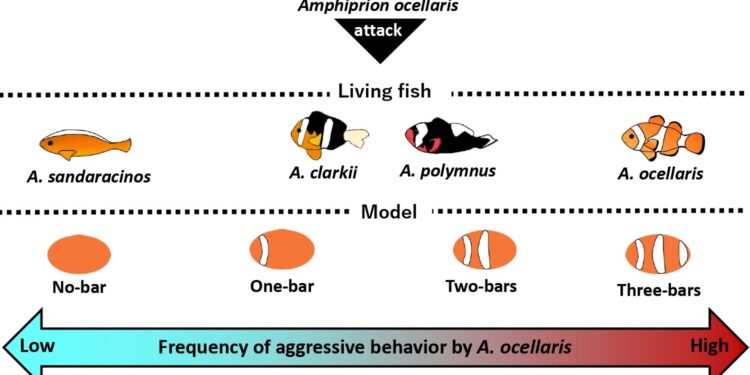Figure showing the aggressive behavior of Amphiprion ocellaris, or clownfish, in response to different species of clownfish, live and model. Credit: Kina Hayashi
The clownfish (also known as the anemonefish) is a brave little creature that enthusiastically defends its anemones against intruders. And while it’s sometimes nice to share with clownfish of other species, it’s never cool to live with intruders of their own species: they always receive the coldest reception. So how does the clownfish distinguish members of its own species from other striped fish?
Clownfish species that live in the same locations tend to have a wide range of striped patterns, from three vertical white bars to none, according to Kina Hayashi of the Okinawa Institute of Science and Technology, Japan. Would the clown fish be able to count the number of white stripes on the bodies of other fish to distinguish friend from foe?
Kina Hayashi and colleagues published the surprising discovery that the common clownfish (Amphiprion ocellaris) can count in Journal of Experimental Biology.
To find out, Hayashi, Noah Locke and Vincent Laudet raised a school of young Nemos, a common clownfish, from eggs to ensure that the fish had never laid eyes on other species of Clown fish.
Once the young were about 6 months old, Hayashi filmed their reactions to other species of clownfish, including Clarke’s clownfish (A. clarkii), orange skunk clownfish (A. sandaracinos), and the saddleback clownfish (A. polymnus), as well as intruders in their environment. own species, to find out how they reacted.
Clownfish (Amphiprion ocellaris) photographed in the wild. Credit: Kina Hayashi
Sure enough, the common clownfish gave members of its own species, with three white bands, the hardest time, facing 80% of the fish for up to 3 s and even maintaining an 11 s stalemate with one fish.
On the other hand, intruders of other species had it easier: the orange skunk clownfish – with no sidebars and a white line along its back – came off the lightest and was barely confronted, while that Clarke’s clownfish and saddleback clownfish – with two and three white bars, respectively, were slightly intimidated.
“Common clownfish…most often attacked their own species,” says Hayashi. But how did clownfish distinguish between members of their own species and others?
This time, the team isolated small schools (three fish) of young common clownfish in individual tanks, then filmed the fish’s reactions to either a regular orange fish model or models painted with a, two or three white stripes, keeping count of how often the fish bit and chased away the offending intruder.
Sure enough, the young clownfish paid little attention to the plain orange pattern, similar to the lack of interest they had shown in the orange skunk clownfish, as they chomped and chased the pattern with a single bar of from time to time. However, they really turned up the heat on the three-stripe models; they didn’t like sharing space with three-barred strangers who looked like them. And the two-striped models were also bullied.
Plastic models used to measure aggressive behavior of clownfish. Credit: Kina Hayashi
Hayashi suggests that clownfish’s aversion to two-barred fish might be linked to their development. The common clownfish initially forms two white bands at about 11 days of age before gaining the third three days later. She suspects that clownfish that grow up with other two-striped young might see fish with two white bars as competitors to chase.
For example, young common clownfish that dwell in anemones can distinguish between species that pose a threat and those that do not based on the number of white bars on the sides of the fish. This allows them to defend their home against intruders who might try to evict them, while paying less attention to fish of other species that have little interest in taking up residence in their anemone residence.
More information:
Counting Nemo: The clownfish Amphiprion ocellaris identifies species by the number of white bars. Journal of Experimental Biology (2024). DOI: 10.1242/jeb.246357. journals.biologists.com/jeb/ar …i/10.1242/jeb.246357
Provided by The Company of Biologists
Quote: Scientists discover that clownfish count stripes to tell friends from foes (February 1, 2024) retrieved February 1, 2024 from
This document is subject to copyright. Except for fair use for private study or research purposes, no part may be reproduced without written permission. The content is provided for information only.



